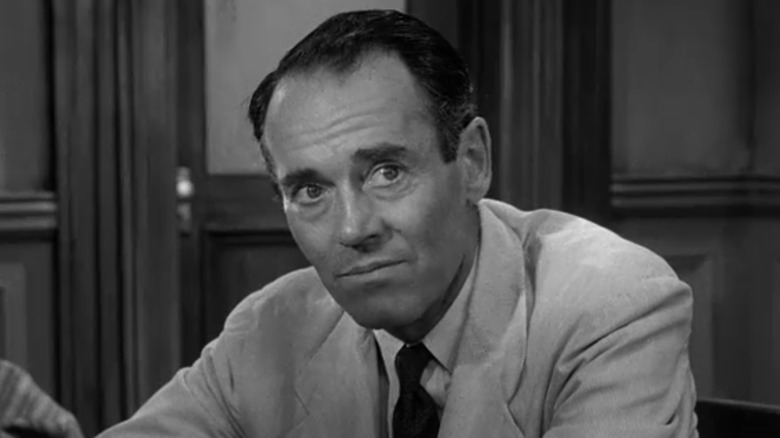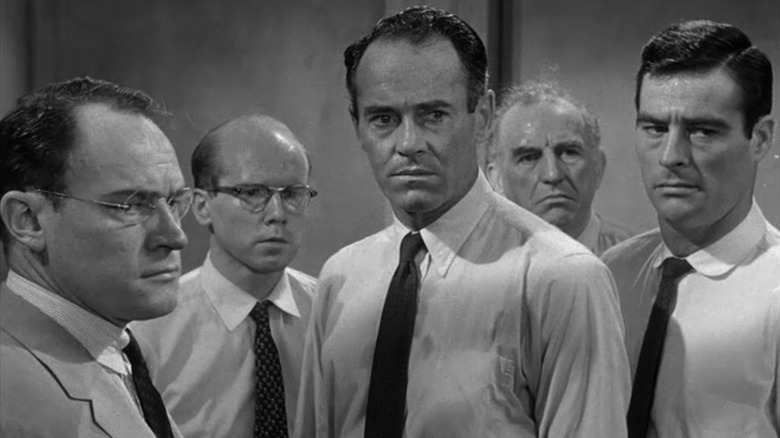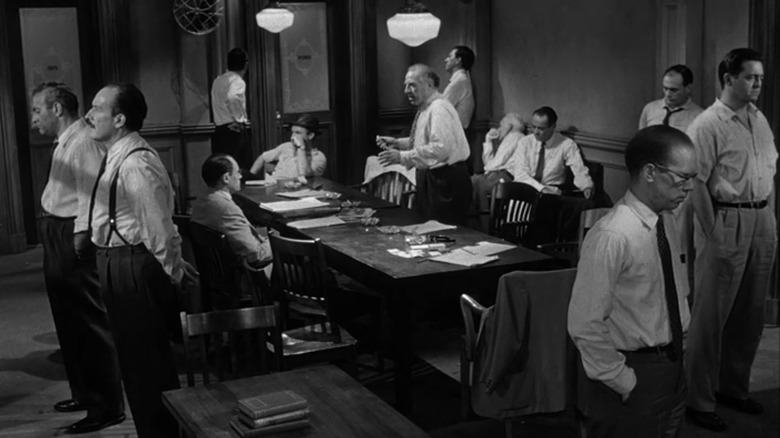How Sidney Lumet Used Different Eye Levels To Create Tension In 12 Angry Men
When you go to film school, you read a lot of books about how to make a movie. A lot of them I did not care for. Too many to count frame the moviemaking process as a puzzle to be solved, telling you how to tell the story that is in your head in the most conventional, easily accessible way. For some reason, the commercial angle of a film is more important than the artistic one. Of course, the screenwriting book "Save the Cat! The Last Book on Screenwriting You'll Ever Need" by Blake Snyder is the worst offender in this regard, but so many other books fall into this trap. They foster formula, rather than expression.
For my money, the greatest book I ever read about what goes into making movies came from one of the greatest directors in the history of American cinema. I am talking about Sidney Lumet, the director of classics such as "Network," "Dog Day Afternoon," and "The Verdict." In 1996, Lumet published a memoir/how-to hybrid book called "Making Movies" that I found to be an invaluable source for the filmmaking process when given the book in college. First of all, Lumet was a just a terrific writer, particularly in his use of humor. He could make describing the technical nuts and bolts of filmmaking transcend what could so easily become a dull blur of words through his wit and love of the craft. Every detail of what makes a great film jumps off the page, and his passion for the art form is truly infectious.
The key to making the book work is that Lumet never tells exactly tells you how to do something. Sure, he will tell you how the camera works, how to choose a lens, and other things like that, but he never claims any of his methods are how the process should be done. He will explain a filmmaking technique and give an example as to how he utilized it in his own work, but Lumet makes it quite clear that everything he is teaching you are tools. Those tools must then be used for exploration. They are there to serve your story, not to dictate it.
For instance, he talks about designing his debut feature "12 Angry Men," and how he could use camera positioning and different lenses to better tell his story.
'Hey, it's a camera!'
Almost the entirety of "12 Angry Men" takes place in one room, a small space in a courthouse for the jury to deliberate a murder trial. Having such a limited space to tell your story creates a litany of challenges for the director, as people around a table talking is not necessarily what someone would deem "cinematic." That kind of storytelling has a much more natural fit in theater than on film. Varying how you use the camera over the course of the 96 minute running time requires careful design and planning.
In the chapter "The Camera: Your Best Friend" in "Making Movies," Sidney Lumet writes about how the ways you can use a camera made shooting "12 Angry Men" not nearly as complicated as it seems on the surface:
"It never occurred to me that shooting an entire picture in one room was a problem. In fact, I felt I could turn it into an advantage. One of the most important dramatic elements for me was the sense of entrapment those men must have felt in that room. Immediately, a 'lens plot' occurred to me. As the picture unfolded, I wanted the room to seem smaller and smaller. That meant that I would slowly shift to longer lenses as the picture continued. Starting with the normal range (28 mm to 40 mm), we progressed to 50 mm, 75 mm, and 100 mm lenses."
Lens choice is an under-discussed aspect of filmmaking in the popular lexicon, but it is one of the most important elements of every single shot in a film. To boil things down, lenses essentially fall into three categories: wide, normal, and long. Wide lenses, which are generally 9-28 mm lenses (meaning the thickness of the lens), have a wider field of vision to capture an image. They also distort the image, exaggerating features of things close to the camera and creating a greater separation from the foreground and background. The work of the Coen Brothers is a good place to examine what wide lenses look like, as they almost use them exclusively. Normal lenses (generally 28-50 mm) have a narrow field of vision than wide ones and do a decent job of replicating that of a general observer. Depth is pretty standard, and there's minimal distortion. Long lenses (lenses over 50mm) have the narrowest field of vision, and the separation between the foreground and background collapses significantly the longer the lens is. Take a look at the "Mission: Impossible" films for the use of long lenses.
Whatever lens you choose does not just determine what you are capturing, but how you capture it. Depending on what you want to have the audience feel in any particular moment requires a different lens. The distortion of a wide lens could aid in making something funny or uneasy, and a long lens could make something more voyeuristic. For "12 Angry Men," having the lenses get longer as the film progresses perfectly boxes those 12 guys in that room they are not allowed to leave, as the depth of field condenses and the area you can see becomes smaller. For Lumet, that was the way to go, but if another filmmaker helmed that production, they just as easily could have decided to use wider lenses late in the film, emphasizing the extremity in these men's faces the more vehemently they argue with each other. It's all a matter of knowing the tools you are working with, understanding the material, and finding the right melding of the two for your own perspective.
On the level
While the lens choice was apparent to Lumet, the positioning of the camera provides an even more difficult task for a filmmaker when you are making a movie in one room. There are only so many places that you can put the camera, particularly in 1957 when cameras were much bigger than they are today. Because of the limited spaces to position the camera, Lumet had to rely on the height of the camera to progress the story visually. He writes in "Making Movies":
"In addition, I shot the first third of the movie above eye level, and then, by lowering the camera, shot the second third at eye level, and the last third from below eye level. In that way, toward the end, the ceiling began to appear. Not only were the walls closing in, the ceiling was as well. The sense of increasing claustrophobia did a lot to raise the tension of the last part of the movie. On the final shot, an exterior that showed the jurors leaving the courtroom, I used a wide-angle lens, wider than any lens that had been used in the entire picture. I also raised the camera to the highest above-eye-level position. The intention was to literally give us all air, to let us finally breathe, after two increasingly confined hours."
Through these techniques, he really makes that jury deliberation room its own character, which is fighting against the men just as much as they are fighting with each other. For someone making his first theatrical feature film, being able to harness these methods so expertly the first time out is incredibly impressive. Prior to this film, Lumet had done an extensive amount of work on television, and I have no doubt that working in a medium that frequently featured long scenes in one location due to budget prepared him perfectly to tackle this kind of material.
"Making Movies" is filled with stories like this about how he crafted his films. He talks about shooting the same scenes in "Murder on the Orient Express" with two different kinds of lenses based on where in the movie they appear and from whose perspective. And in "Network," he has the lighting become more and more artificial and cold as the film goes on to reflect the souls of these television executives leaving their bodies. Lumet writes in plain, simple, and entertaining terms about his thought process behind so many of cinema's greatest movies that it is rather difficult to not just want to go pick up a camera immediately and start shooting something. Even if you are not compelled to make a picture, it is a valuable resource to help improve your literacy as a film watcher, giving you a greater understanding at how to understand cinema.
Now, go back and watch "12 Angry Men" again and really see how Lumet visually tells that story with these techniques. You will have a greater appreciation for just how exceptional that film is.


